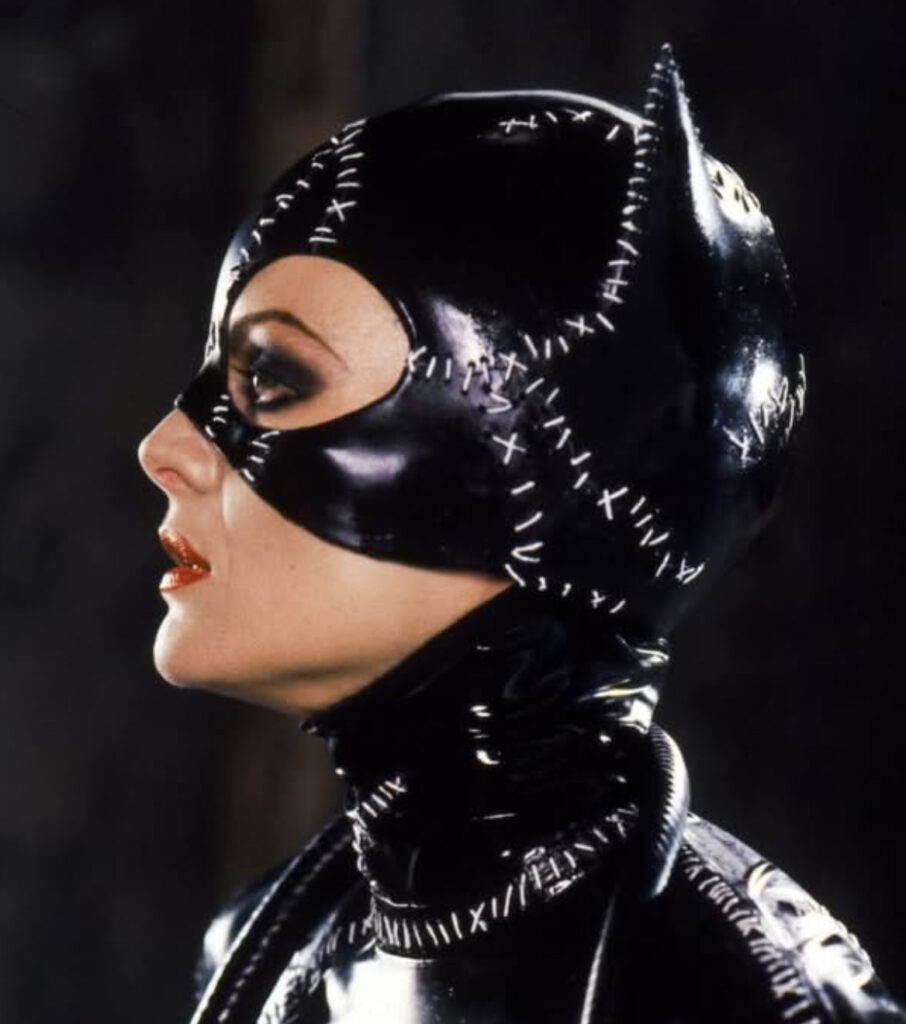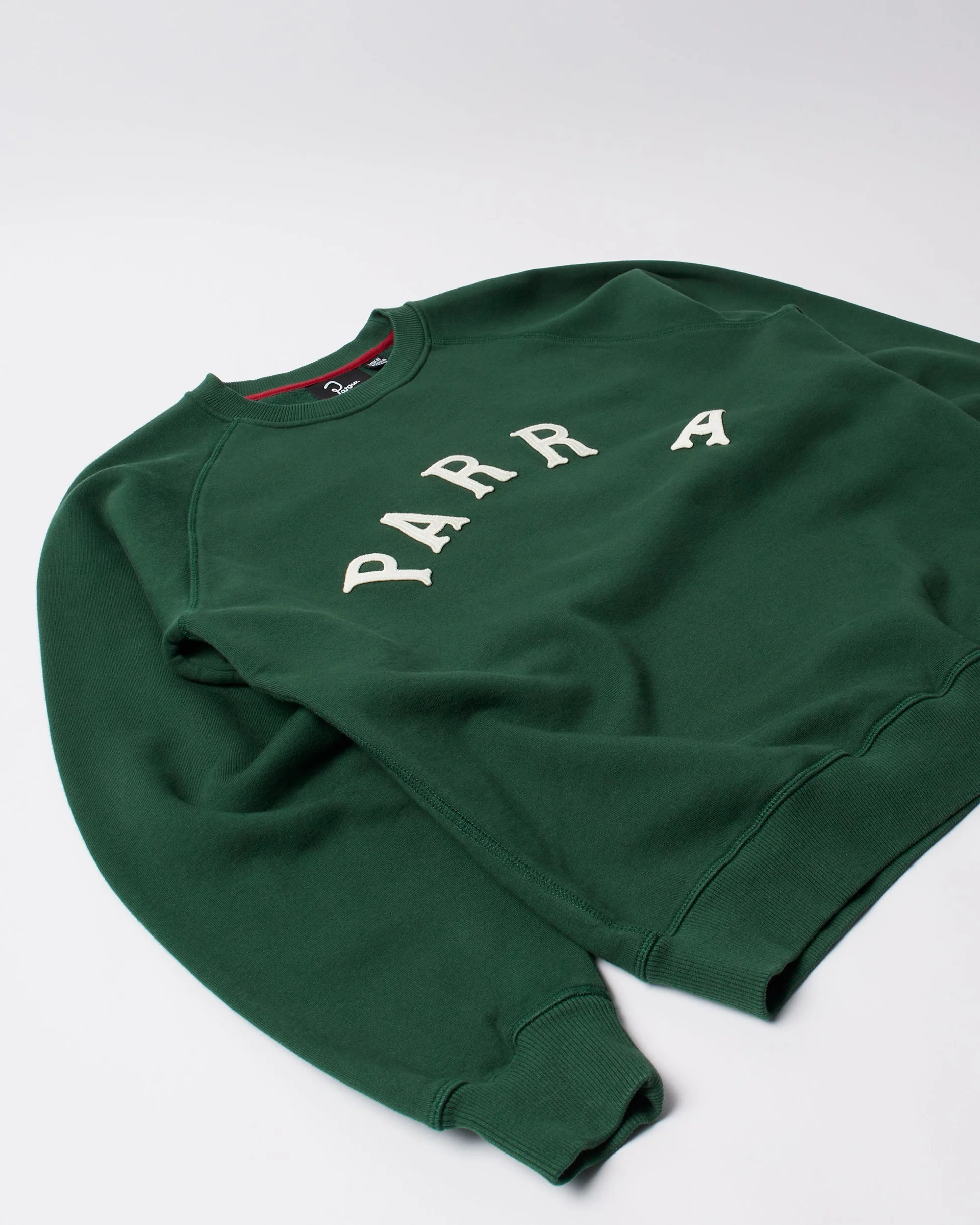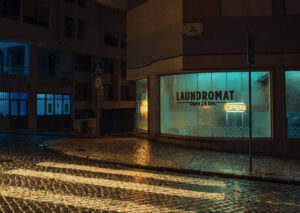A cultural, aesthetic, and cinematic dissection of the most feral femme fatale in superhero history
There are images that transcend their cinematic context—frames that escape the screen and become myth. One of the most enduring is a publicity still of Michelle Pfeiffer as Catwoman for Tim Burton’s Batman Returns (1992): she stands coiled and cracked in latex, a figure of stitched rebellion and feline grace, glaring with both sex and sadness into the lens of pop culture. This isn’t just a costume. It’s a cinematic exorcism.
In this image—arguably one of the most iconic in comic book cinema—Pfeiffer’s Selina Kyle is fully realized: seductive, splintered, stitched together from trauma and rebirth. Behind the gloss and goggle-eyed ferocity is something that transcends character performance. It’s an entire thesis on femininity, power, pain, and theatrical rage.
THE COSTUME AS CHARACTER
Bob Ringwood and Mary E. Vogt’s design of Catwoman’s suit is a feat of Gothic innovation. It’s not simply tight. It’s suffocating. Black patent vinyl vacuum-sealed to Pfeiffer’s skin, stitched together with thick, white, jagged seams like a Frankenstein construct—a visual cue that this woman has not just been broken but remade violently.
The publicity photo makes this especially clear. Shot in high contrast with heavy shadows, her suit catches every glint of studio lighting, creating a sense of kinetic energy even in stillness. The seams, inspired by bondage culture and surgical scarring, aren’t just visual flair—they’re architectural scars. The costume tells its own story: not just a symbol of sex appeal, but of psychological fragmentation.
Where prior iterations of Catwoman (like Julie Newmar or Eartha Kitt) leaned into camp, Pfeiffer’s version is tragic operatic horror. The image of her, frozen mid-pose in that glossy black skin, becomes more than publicity—it becomes prophecy.
THE AESTHETICS OF FURY
Her mouth, crimson with smeared lipstick, often half-open in a growl or shout. Her hands—gloved claws—reaching toward something off-frame, either to slash or seduce. Her eyes outlined in thick, aggressive black, wide and haunted beneath the cat-shaped cowl.
These elements are not just makeup or gesture. They are design grammar. They’re Burton’s idea of a psychological fairy tale manifested in one woman.
What makes Pfeiffer’s Catwoman unforgettable is that she’s terrifying in stillness. She doesn’t have to move to radiate energy. The publicity photo captures this precisely—her body tensed, her glare unflinching, the cracks of her persona (literalized by the costume seams) visible in every square inch of frame.
In a film known for its maximalism—Penguin’s grotesque nihilism, Batman’s noir brooding—Catwoman stands alone in clarity. She is the only character whose narrative is internal and bodily. She wears her story.
A PERFORMANCE IN THREE OCTAVES
Michelle Pfeiffer’s performance in Batman Returns is a high-wire act between vulnerability, madness, and eroticism. She plays Selina Kyle before the transformation as a skittish, overlooked secretary—mumbling, apologizing, shrinking. After a symbolic fall and feline resurrection, she returns with new command: snarling, whip-cracking, smiling with menace.
The publicity photo captures the post-resurrection persona—Catwoman not in motion, but in total control. It’s the moment after she’s slain her former self, after she’s said “Life’s a bitch. Now, so am I.” She’s unhinged, yes, but purposefully so.
This performance isn’t one of villainy. It’s revenge psychodrama. Pfeiffer builds Selina’s arc not from comic book archetypes, but from rage, heartbreak, and a sense of claustrophobic domesticity cracked open like a mirror. She doesn’t want to destroy Gotham—she wants to reject the lie that she ever belonged in it.
FEMME FATALE AS FABLE
Pfeiffer’s Catwoman stands at a nexus: she is the spiritual heir to noir seductresses like Barbara Stanwyck and Gilda, but filtered through a feminist crisis. She’s not a temptress by design. She’s a reaction.
Her costume isn’t just about male gaze—it’s a rebuke of it. That’s the trick the 1992 image plays on the viewer. You’re meant to look. You’re meant to desire. But the more you do, the more the seams begin to mock you. It’s uncomfortable because it reverses the lens.
In interviews, Pfeiffer recounted the physical pain of wearing the costume—how it was vacuum-sealed, glued, and impossible to sit in. The discomfort became a method. She moved like a predator because she had to. Her body was trapped in a suit that mirrored her character’s state of being: ornamental, explosive, designed for spectacle but agonizing within.
There’s a reason the image haunts. It asks: What does it cost a woman to become untouchable?
BURTON’S FAIRYTALE NIGHTMARE
In Batman Returns, Tim Burton trades the gritty realism of Nolan’s later vision for a baroque nightmare—a Christmas-time operetta of freaks and orphans, stitched together with snow, fire, and abandonment. Within this stylized unreality, Pfeiffer’s Catwoman feels the most real.
The photo captures this perfectly. She’s not a cartoon. She’s a warning. She embodies the grotesque beauty Burton adores—where creatures are more human than heroes, and masks reveal more than they conceal.
Gotham is not a city in Batman Returns. It is a mental state. It is anxiety, repression, denial. And Catwoman claws through it like a psychological arsonist, refusing to behave, refusing to belong.
THE CULTURAL BACKDROP
Since 1992, no Catwoman has matched Pfeiffer’s spectral presence. Anne Hathaway’s rendition in The Dark Knight Rises was sleek and competent but emotionally remote. Zoë Kravitz, in The Batman (2022), added texture and realism, but leaned into noir melancholy over horror.
But Pfeiffer’s Catwoman still feels singular because of how nakedly mythic she is. She’s not just a version. She’s the archetype.
Her photo has circulated for decades on posters, T-shirts, memes, and film retrospectives—not because it promotes the movie, but because it encapsulates an energy that the genre rarely allows: female rage as operatic spectacle. And it’s not sanitized. It’s not empowering in the usual sense. It’s dangerous. It’s gorgeous. It’s earned.
THE STILL THAT MOVES
Publicity stills are often dead images—engineered glamour. But Pfeiffer’s Catwoman transcends that. The frame is alive with story. You don’t need context. You don’t even need to know who she is.
Her expression, her body language, the glossy threat of her silhouette—all of it speaks. She’s not asking to be liked. She’s not even asking to be understood. She’s declaring something: You looked at me once and saw nothing. Now you will never look away.
And that’s the legacy. Not just of the character, but of the moment captured. A woman remade by pain and dressed in the seams of her own undoing.
Impression
Pfeiffer’s Catwoman dies, and she doesn’t. She disappears. She lives in rumor. She haunts the skylines of other Batman films, even when she’s not present. And that’s why the 1992 image still burns: because it feels like she’s still out there—slashing tires, rejecting apology, rewriting every script she was left out of.
In the end, Batman Returns wasn’t about Batman. It was about duality, transformation, and who gets to tell their story after death.
Pfeiffer’s Catwoman told hers. With claws. With whip. With seams that refused to close. And with one perfect photo that said everything a monologue never could.
No comments yet.








